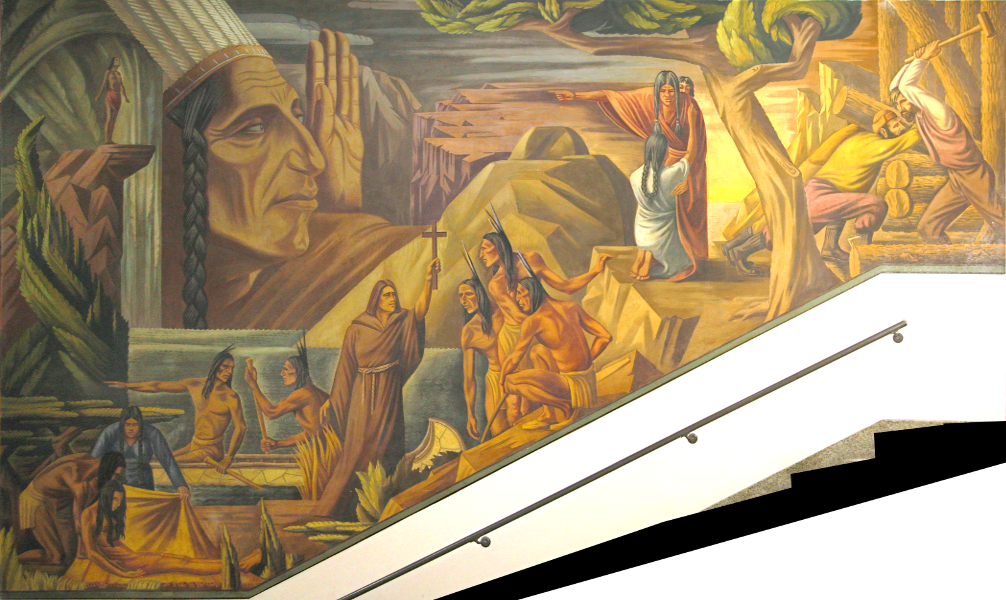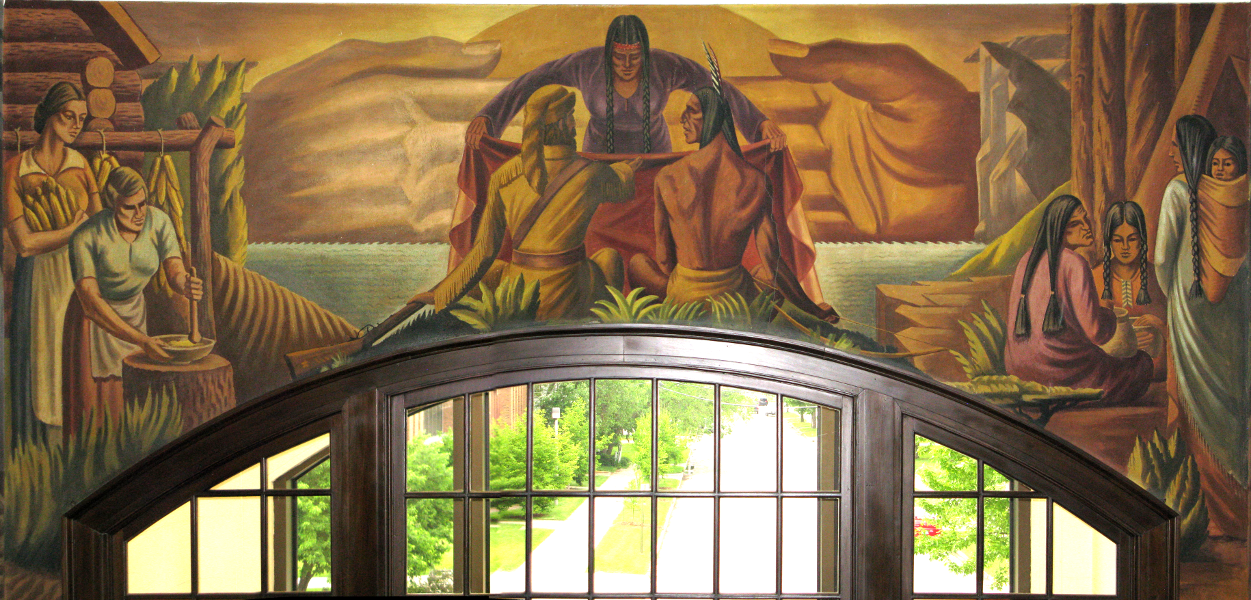Information
John Martin Socha painted a set of murals for the Teacher's College in Winona, Minnesota, now part of Winona State University. The murals depict a version of Winona's history, attempting to include both the white settlers who founded the modern town of Winona and the Native Americans who had inhabited this area for centuries before the coming of the whites.
The murals consist of three panels, two flanking a stairway into the Somsen Hall, and a third over the doorway to the stairs.
On one wall there is a depiction of "The Legend of Winona," the story of a young woman's suicide in the wake of an unhappy forced engagement.
The mural shows Winona before she has thrown herself off of a cliff and when her body has been recovered at the base of the cliff. But a larger portion of the mural is taken up with a priest introducing Christianity to a trio of Native American men, and white woodsmen cutting down the local forest. The large image of the head of a Native American chief is shown gazing wistfully in the direction of the white woodsmen.Opposite "The Legend of Winona" is a panel showing "Winona's Early Settlers," meaning the white settlers who largely displaced the original Native American inhabitants. Paralleling the chief in the panel opposite, this panel features the head of Orrin Smith, the steamboat captain credited as the white founder of Winona. Smith is shown looking boldly out from the mural, flanked by the smokestacks of his steamship and surrounded by industrious workers building the new city.
Between these two panels is a tribute to friendship between the whites and the Native Americans, "Frontiersmen and Indians Coming Together," which shows domestic scenes of both groups and the meeting of two representatives against the background of two hands approaching in friendship.
Although these murals represented the traditional view of the era in which they were painted, they were harshly criticized in modern times for the patronizing attitude they took toward their Native American subjects. Winona State University resisted calls for the murals' removal, choosing instead to present the murals with text that provides historical context and instruction. We reproduce this text below. One piece, "The Somsen Hall WPA Mural: A Dakota Perspective," was written by Jill Ahlberg Yohe, the Assistant Curator of Native American Art at the Minneapolis Institute of Art. The other, on "The Founding of Winona" and "The 1851 Treaties," was written by Iyekiyapiwin Darlene St. Clair, an Associate Professor at Saint Cloud State University.
Muralists paint stories of place, history, identity, and belonging. They create murals to mythologize a story in time and place, guided by particular viewpoints. During the Great Depression, hundreds of murals appeared on walls across the country, sponsored by various New Deal programs, including the Works and Progress Administration, developed to put unemployed Americans back to work. These paintings were made to illustrate the history of "progress," "civilization," and work within the history of the United States. While the federal arts programs sought to represent a range of experiences, artists like this muralist, John Martin Socha, portrayed Indigenous people through the lens of mainstream ideology at the time. These romanticized and inaccurate depictions of Indigenous people as "Noble Savages" are now recognized as demeaning in the 21st century. Portrayals of Indigenous people and of U.S. history, however, become opportunities to revisit and reframe the past, and offer places for important, candid conversations about Indigenous struggles and achievements of yesterday and today.
Minnesota artist John Martin Socha was commissioned to create a mural depicting the birth and development of the town of Winona. Socha was a student of perhaps the most famous muralist, Mexican artist Diego Rivera. Socha completed this mural in 1938. In addition to his work in Winona, his murals can be seen today in the Kiehle Auditorium at the University of Minnesota at Crookston and New Ulm High School.
The mural is read right to left and is meant to depict Winona over the course of time chronologically, a place of progress and development from a particular perspective.
Because of this, the painting begins with a scene of white male settlers in the 19th century, building a homestead from the abundant trees and mill indicustries of the area. The insertion of white settlers at the beginning of the mural creates an incorrect narrative of history, and stakes rights and claims to a territory already thriving with activity and settled by Indigenous people for millenia. The first appearance of Indigenous people happns next, and Socha fashions these portrayals romantically. Rather than revealing Indigenous people as living in highly sophisticated, complex cultures with vast trade networks and social systems, he present them primitively, as mere inhabitants of the land and "closer to nature." The mural creates a palpable sense that history is inescapable, where Indigenous people will inevitably disappear and will surrender to Cristian "salvation" and their forced removal.
The large portrait of an Indigenous man, with sharply sculpted features and haunting eyes void of pupils is looking to the right, a signal to the white viewer that Indigenous cultures have long vanished from the land. Winona, a narrative of a tragic Dakota woman betrayed by love, is portrayed naked from the waist up, plunging to her death. The center panel above the doors depicts an Indigenous woman holding a blanket for a white trapper and an Indigenous man in deep discussion.
The left side of the mural depicts white women fully clothed, making bread in a dark room, working hard in the domestic sphere, yet isoated from public activities associated with the "advancement" of the white settlement. In contrast, in the center of the left wll rests a large portrait of Orrin Smith, the European American steamboat captain credited with founding the city of Winona. Unlike the Indigenous man directly across the mural, portrayed as looking backward to the past, Smith looks directly forward with steely determined eyes, steering his ship and his city foward to the future.
Notice the color palettes of the two main panels. On the right panel with depictions of Indigenous people, the mural is painted in muted browns and earthy tones, colors often associated with nature and simplicity. In contrast, the left panel of white settlers and workers is painted in a cold blue, a sign of industrial development and dominant ideas of progress.
The panel ends with two white male workers, complex figures that show industriousness and determination, but they are also figures who are subjects of industrialization.
In 1851, Dakota people signed the treaty of Traverse de Sioux by which the United States government seized more than half of what is now Minnesota, a treaty that was filled with inaccuracies and illegalities with devastating consequences for the Dakota. (See side panel). In November 1851, before the two 1851 treaties were ratified by the U.S. Senate, Orrin Smith, a European American steamboat captain familiar with this stretch of the Mississippi River, established a claim to land in the place that would soon become the city of Winona.
Oct. 11, 2017
Jill Ahlberg Yohe, Ph.D.
Assistant Curator of Native American Art
Minneapolis Institute of Art
Winona is named for either the sister or cousin of Wabasha (Wapahasa), one of the Dakota leaders with this name who had a village at Wabasha's Prairie, the future site of the city of Winona. The name Winuna refers to the first-born in a Dakota family who is a girl.
The city of Winona was founded in 1851, just months after the two 1851 treaties were signed. Orrin Smith, credited with founding the city of Winona, was a steamboat captain who was familiar with the region.
The story of Winuna was told by different Dakota people to several early visitors including Zebulon Pike (1805), Stephen Long (1817), William Keating (1823), William Joseph Snelling (1830) and Mary Eastman (1849). The story tells of a young Dakota woman who is matched with a man she does not accept. Her response was to throw herself off what would be named "Maiden Rock" at Lake Pepin. This narrative is reflected in the Socha mural. [See Warren Upham, "Minnesota Place Names," 2001, p631.]
While this story was shared by Dakota people, newcomers to Mni Sota Makoce were attracted to the tragedy of this story. In reflecting on hearing this story, Zebulon Pike stated that Winona's suicide "ended her troubles" and he praised her actions as "a wonderful display of sentiment in a savage!" [See G. Hubert Smith, "The Winona Legend," Minnesota History, December 1932, p367.]
They knew -- or thought they knew -- what was best for the Indians, and the end justified the means. By a remarkable coincidence, what was deemed best for the Indians was invariably also to the advantage of the government, the traders, and, above all, the land-hungry settlers. [See Roy Metery, "The History of the Santee Sioux," 1993, p78.]
The treaties of Traverse des Sioux and Mendota were negotiated in the summer of 1851. Negotiations began with the Sisiunwan and Wahpetunwan bands. Having less experience in treating with the U.S., these bands were engaged first. After signing the original treaty, each signer was ushered to another document for signature. This document, now referred to as the "Trader's Papers," stipulated that the traders would be forst compensated for debts they claimed. These claims consumed the majority of the money set aside for the Dakota -- funds the Dakota would need to live on for the following year.
On July 29, negotiations began with the other two bands, the Bdewakantunwan (or Mdewakantunwan) and the Wahpekute. These bands had more experience in treaty-making with the United States. Leaders of these bands had many grievances from previous agreements that hadn't been addressed or resolved. However, because the other bands had already signed treaties, it gave the Bdewakantunwan and Wahpekute few options.
These two treaties encompassed much of the southern half of Minnesota and placed Dakota people on reservations. The dishonest actions of the United States in these treates provides important context for what would come in 1862.
Oct. 11, 2017
Iyekiyapiwin Darlene St. Clair
Associate Professor
Saint Cloud State University


